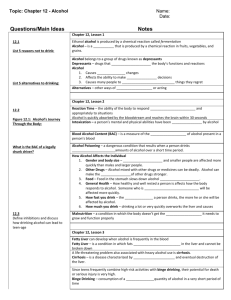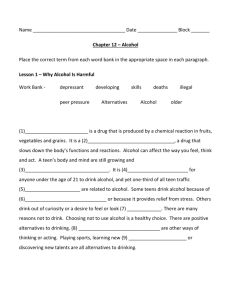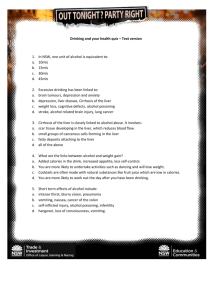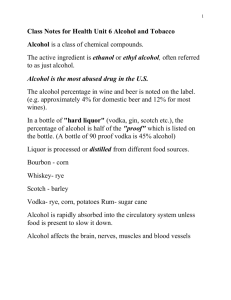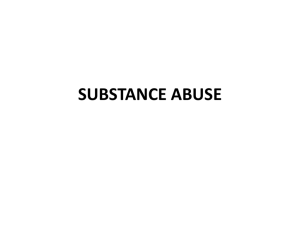New Alcohol PPT
advertisement
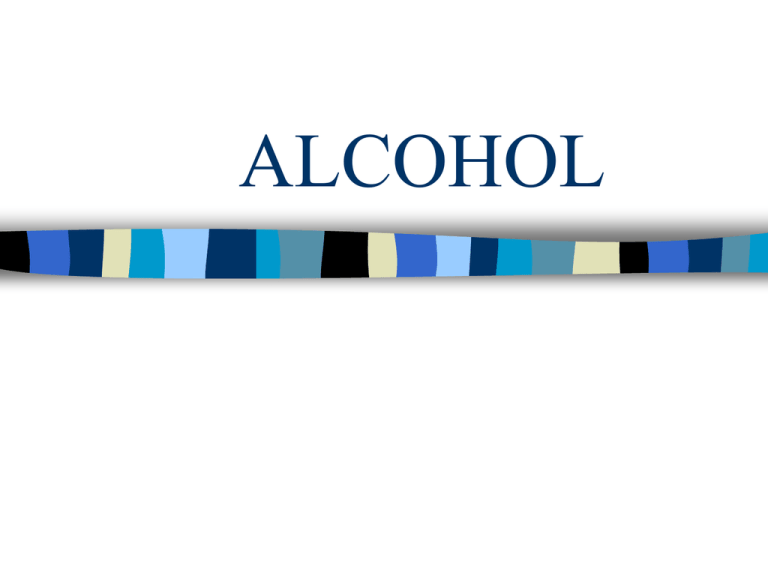
ALCOHOL American Prohibition Article 1. 2. 3. 4. 5. 6. Who was the first state to pass a law prohibiting the sale of alcohol? What events lead to the ban of alcohol? What amendment banned the manufacture, sale & distribution of alcohol in the US? What happened after they banned alcohol? What amendment repealed the 18th amendment? What were underground/illegal bars called? History In 1851, Maine became the first state to pass a law prohibiting the sale & manufacture of alcohol. 18th Amendment – (1919) U.S. prohibited sale & manufacture of alcohol. 21st Amendment- (1933) repealed the 18th amendment, now the control of manufacture and sale of liquor became a state responsibility. Alcohol Today Nation’s #1 Drug Problem 100+ million adults (60-70% of total population use) – Used more than any other drug 10+ million adult alcoholics 4.5 million teenage alcoholics/ problem drinkers 40,000 + alcohol poisoning cases a year 8,000 teens die each year in alcohol related crashes Alcohol Today ½ of all crime – 75% of violent crimes Alcohol is negatively linked with violence, rape, suicide, breaking the law, academic apathy, accidental death, injuries, irresponsible decisions, STI/ STDs, job loss, divorce, and serious illness. Alcohol related diseases lead to 12,000 deaths/ year – #1 Cirrhosis of the liver ( hardening of the liver) Motor Vehicle Deaths Why have alcohol related motor vehicle deaths decreased in the last decade? 1. Site 1 2. Site 2 CDC 3. Site 3 MADD Classes of Drinkers (3 classes) Social – Moderate, safe amounts consumed by adult (21 yrs or older) Problem – Self or others at risk, binge drinker Alcoholic – dependent Class of Drinkers About one in ten drinkers is or will become an alcoholic/problem drinker. Most adults who drink in the U.S., drink as a “social” drinker. Responsible (over 21) Alcohol Use Know limit Space out drinks Small glasses Dilute mix drinks Eat while consuming Don’t drink and drive Don’t drink and use medication Don’t drink if pregnant or not sure – Baby’s of mothers who drink may be born with fetal alcohol syndrome (FAS) FAS is a leading cause of mental disability. Vocab AlcoholFermentationDistillationProof% of alcoholWhat are the 3 types of alcohol? 1 Drink (1/2 oz of pure ethanol- active ingredient) One 12 oz can of beer (4.5% alcohol) 1 ¼ oz of 80 proof hard liquor (distilled) (40% alcohol) – Proof: amount of alcohol in a beverage as measured by %, double the % of alcohol • Ex/ Beverage with 20% alcohol is 40 proof (page 411) 1 oz of 100 proof liquor ( 1 shot) 3-5 oz of wine (12-14% alcohol) 1 wine cooler (1.5-6 % alcohol) Non-alcoholic Beer- contains some alcohol (less than 1%) Alcohol & the Body About 20% of alcohol consumed is absorbed into bloodstream through stomach walls. The majority is absorbed through intestine walls. The remaining alcohol is excreted through urine, perspiration, or breath. How Alcohol Affects the Body Nervous system- Brain- is being deprived of oxygen Impairs senses, vision, hearing Impaired motor skills, reaction time, judgment Mood & personality changes Hallucinations Violent & angry behavior Nervous System/ Terms • Blackouts (a period in which a person cannot remember what has happened) Type of amnesia • Seizures• Dementia (decline in all areas of mental functioning) Digestive system – Developing cancers of mouth, esophagus, & stomach – Ulcers, open sore-irritation from the toxins in alcohol – Malnutrition-drinking interferes with absorption of nutrients – Liver disease (cirrhosis) • Stage I- fatty deposits on the liver • Stage II- Alcohol Hepatitis, liver swells, abdominal pain, fever, yellowing of skin • Stage III- Cirrhosis/Hardening of liver (NO CURE) Immune & Respiratory Systems – Increased risk of developing illnesses *** Alcohol decreases the amount of infection fighting cells -you get sick a lot quicker and can not recover as quickly. • Respiration infections • Tuberculosis- lung infection • Cancers can occur much quicker Affects on Body Cardiovascular system – Damages heart & blood vessels – Alcohol is high in FAT & SUGAR causing the arteries to become clogged with fatty tissue, increasing amount of force to push blood through the vessels. – Increased risk for cardiovascular disease, heart disease, high blood pressure, high cholesterol, heart attack & stroke. Skeletal System/ Muscular System Alcohol causes the bones to lose calcium and takes nutrients out of the body. Bones become thin & brittle and can lead to Osteoporosis, a condition in which the bones become thin & brittle. This also causes injuries for frequently. Muscles- tissue starts to deteriorate. Urinary System Alcohol causes an increase in urine flow. Heavy & chronic drinking can cause the kidneys to shut down. Kidneys- an organ that filters the blood & excretes waste products. Pancreas- releases hormones to regulate blood sugar. Alcohol use can lead to diabetes if the pancreas fails to produce hormones that regulate blood sugar. Reproductive System- puberty Females -delay the menstrual cycle, or cause an irregular cycle. - reduce fertility - risk of breast cancer - early onset of menopause Males - effect size of reproductive organs - reduce fertility, reduce sperm count & movement of sperm - decrease muscle mass - impaired sexual performance (impotence- males can’t get an erection) Gastrointestinal System Alcohol causes the stomach lining to become inflamed & irritated. Inflammation of the esophagus Diarrhea & vomiting Cancer of the intestines & colon Inflammation/irritation of the intestines Increases secretion of stomach acids Alcohol Affects Every Cell in the Body Most alcohol is changed to harmless waste by the liver – A Healthy Liver can only process about 1 drink/ hour – If drink more then this the excess alcohol build up in the body Alcohol goes to body tissue before excretion – Effects of alcohol intensify – Concentration of alcohol in blood increases Hangover- a result of the chemicals used to make alcohol. The only true treatment for a hangover is time! When treating hangover symptoms, you should not use Tylenol, because it can cause permanent liver damage. One of the worst things you can do for a person is give them another alcoholic beverage. Blood Alcohol Concentration (BAC) Higher the BAC, the greater the effects of alcohol on the body. If the amount of alcohol (a toxin) is too large, stomach will reject it – Vomiting Too much of a toxin (alcohol) can be poisonous. BAC is a percentage of alcohol in the bloodstream. What Happens as BAC Increases .02.08-.10.20.40BAC effects BAC Chart Factors that affect BAC Amount consumed Body weight Feelings Amount of food eaten Carbonation of beverage Speed consumed % of body fat Gender Presence of other drugs in blood Age WEIGHT vs. BODY FAT BODY FAT DOES NOT ABSORB AS MUCH ALCOHOL AS MUSCLE DOES 1. Luke 220lbs. 15% body fat Brett 220lbs. 30% body fat 2. Matt 150lbs. 25% body fat Brian 115lbs. 25% body fat Binge Drinking See Handout DefinitionMales: Females: Alcohol Poisoning See Handout 1. Write down what you should do when you suspect someone has alcohol poisoning. 2. Write down what you should never do if you suspect someone has AP. 3. List the 5 signs of alcohol Poisoning. 4. Alcohol is bombarding the brain depriving it of _____ and starts to shut down _______functions. Alcohol Laws Liquor Control Board – Controls all sales of alcoholic beverages Underage Drinking – Zero-tolerance law • Lowers the legal BAC level for intoxicated drivers under 21 yrs of age Driving Under the Influence (DUI) – Breathalyzer test: accurate and common way police check BAC – Under 21 yrs = 0.02 – 21 yrs & over = 0.08 Laws Cont. Parents can not buy alcohol for their children even if it is their own home. Parents can be held accountable & face fines for serving minors on their property. A person under 21 can be arrested for underage drinking in PA if they are: consuming, transporting & possessing alcohol. * See law handout Alcoholism – Disease in which there is physical and psychological dependence on alcohol. – Alcohol is a Sedative Hypnotic. Difficulty controlling behavior Denial Withdrawal – Alcohol Withdrawal Syndrome • Is the reaction of the body when someone stops drinking all of a sudden. – Delirium Tremens » Is a severe form of alcohol withdrawal syndrome in which there are hallucinations and muscle convulsions Genetic Predisposition Definition- you are at a HIGHER risk of developing that disease if one or more of your BIOLOGICAL family members have that disease. Getting Help Alcoholics Anonymous (AA) – Recovery program for people who have alcoholism ( for the alcoholic) Al-Anon – Recovery program for people who have friends or family members with alcoholism Al-Ateen – Recovery program for teens who have a family member or friend with alcoholism
